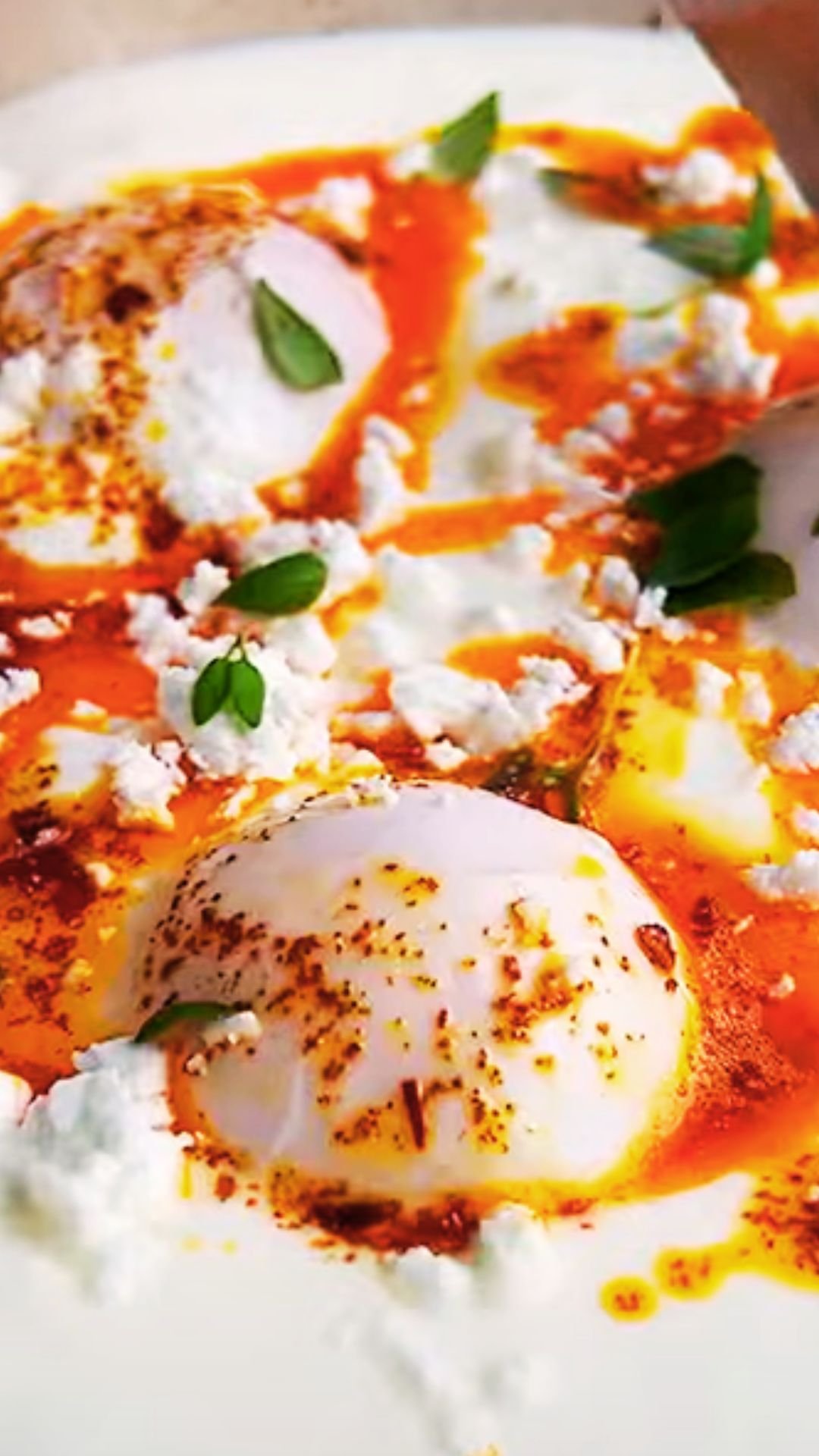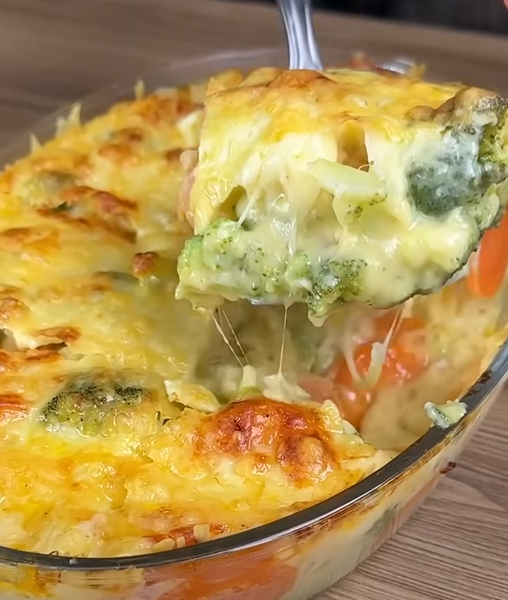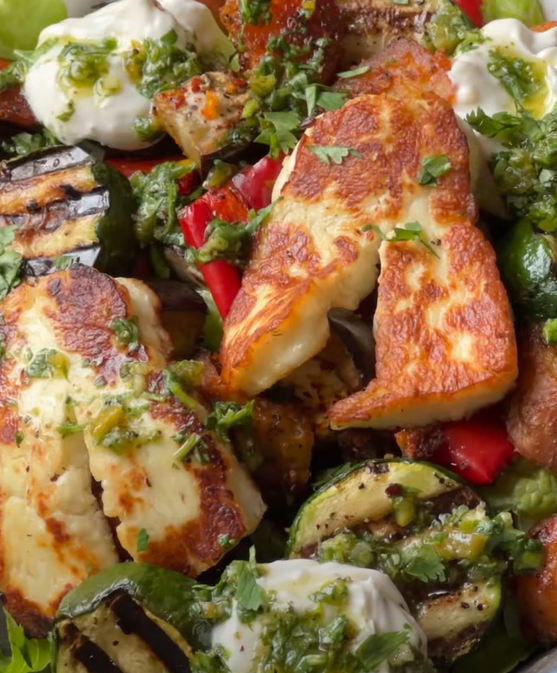When I first discovered Turkish eggs through Tiffani Thiessen’s incredible recipe, I knew I had stumbled upon something truly special. This isn’t just another breakfast dish – it’s a culinary journey that transforms simple ingredients into an extraordinary Mediterranean experience that has completely revolutionized my brunch game.
The moment I saw Tiffani’s interpretation of this classic Turkish dish, known traditionally as Çılbır, I was captivated by its rustic elegance and the way it combines creamy textures with bold, smoky flavors. What started as curiosity about this ancient Ottoman dish has evolved into one of my most requested recipes when hosting weekend gatherings.
The Magic Behind Turkish Eggs
Turkish eggs represent centuries of culinary tradition, dating back to the Ottoman Empire where this dish was served in royal kitchens. Tiffani Thiessen’s version maintains the authentic spirit while adding her signature California-fresh twist, creating a perfect balance between tradition and modern accessibility.
The beauty of this dish lies in its deceptive simplicity. At first glance, you might think it’s just eggs on bread, but each component plays a crucial role in creating layers of flavor that dance on your palate. The creamy labneh provides a tangy foundation, while the perfectly runny yolk creates a luxurious sauce that ties everything together.
Key Components Breakdown
Labneh: This thick, creamy yogurt cheese serves as the foundation Perfectly Fried Eggs: Crispy whites with gloriously runny yolks Charred Naan: Provides texture and a smoky backdrop Chili Butter: The star that brings warmth and complexity Garnishes: Feta, olives, za’atar, and herbs for the finishing touch
Essential Ingredients for Success
Creating the perfect Turkish eggs starts with sourcing quality ingredients. I’ve learned through countless attempts that shortcuts here will compromise the final result.
Primary Ingredients
| Ingredient | Amount | Purpose | Substitution Options |
|---|---|---|---|
| Fresh Eggs | 4 large | Main protein | Farm-fresh preferred |
| Labneh | ½ cup | Creamy base | Greek yogurt (strained) |
| Naan Bread | 2 pieces | Foundation | Pita, Turkish bread |
| Feta Cheese | ¼ cup | Salty accent | Goat cheese, ricotta |
| Mixed Olives | ¼ cup | Briny notes | Kalamata, Castelvetrano |
Chili Butter Components
| Ingredient | Amount | Flavor Profile | Heat Level |
|---|---|---|---|
| Unsalted Butter | ½ stick | Rich, nutty | None |
| Chili Flakes | 1 tbsp | Smoky heat | Medium |
| Smoked Paprika | ½ tsp | Earthy depth | Mild |
| Ground Cumin | ⅛ tsp | Warm spice | None |
Marinated Olives Mix
| Component | Quantity | Role | Flavor Notes |
|---|---|---|---|
| Olive Oil | ¼ cup | Base | Fruity, peppery |
| Garlic | ½ clove | Aromatics | Pungent |
| Shallot | ½ tbsp | Sweetness | Mild onion |
| Fresh Oregano | ½ tsp | Herbaceous | Mediterranean |
| Fresh Thyme | 1 tsp | Earthy | Floral |
Step-by-Step Preparation Guide
My approach to making Turkish eggs has evolved through countless Saturday mornings of experimentation. The key is timing – everything needs to come together while hot for the best experience.
Preparing the Marinated Olives (Make Ahead)
I always prepare these olives the night before, as the overnight marination transforms ordinary olives into flavor bombs that elevate the entire dish.
- Heat olive oil in a small saucepan over low heat
- Add minced shallots and garlic, sautéing for 2 minutes until fragrant
- Incorporate oregano, thyme, red pepper flakes, and herbes de Provence
- Continue cooking for 1-2 minutes until the herbs release their aromatics
- Place olives in a heat-proof glass jar
- Pour the hot oil mixture over olives, ensuring complete submersion
- Cool to room temperature, then refrigerate overnight
Creating the Perfect Chili Butter
The chili butter is what transforms this dish from good to extraordinary. I’ve refined my technique to achieve that perfect balance of nuttiness and heat.
- Melt butter in a small saucepan over low heat
- Continue cooking until the butter begins to foam and turn golden
- Add chili flakes and smoked paprika, stirring constantly
- Cook for 2-3 minutes until the butter develops a nutty aroma
- Add ground cumin and cook for another 30 seconds
- Remove from heat and set aside (it will continue to develop flavor)
Mastering the Egg Technique
The eggs are the star of this show, and getting them right requires attention and practice. I’ve learned that the perfect Turkish egg has crispy, golden edges with a yolk that’s completely runny.
- Heat 2 tablespoons of olive oil in a large frying pan over medium heat
- Once the oil shimmers, gently crack each egg into the pan
- Season immediately with salt and freshly ground black pepper
- Cook for 2-3 minutes until whites are completely set
- The yolks should jiggle slightly when you shake the pan
- Remove from heat while yolks are still liquid gold
Charring the Naan
This step adds a smoky dimension that makes Tiffani’s version particularly special. The char marks aren’t just for show – they add genuine flavor depth.
- Turn a stovetop burner to low flame
- Using tongs, hold each naan piece directly over the flame
- Rotate constantly to achieve even charring
- Look for dark spots without burning through the bread
- The process takes about 30-45 seconds per side
Assembly: The Art of Plating
The final assembly is where the magic happens. I’ve found that the order of operations matters significantly for both visual appeal and flavor distribution.

Plating Sequence
- Foundation Layer: Spread labneh evenly across each piece of charred naan
- Butter Drizzle: Apply chili butter while still warm for maximum absorption
- Egg Placement: Carefully transfer two eggs to each prepared naan
- Garnish Strategy: Sprinkle crumbled feta around the eggs, not on top
- Olive Distribution: Arrange marinated olives artfully around the plate
- Final Touches: Dust with za’atar and finish with fresh parsley
Temperature Considerations
Serving temperature is crucial for the optimal experience. The contrast between the warm eggs and cool labneh creates textural interest that disappears if everything reaches room temperature.
Nutritional Profile and Health Benefits
Turkish eggs offer an impressive nutritional profile that aligns with many healthy eating approaches. Let me break down what makes this dish nutritionally compelling.
Macronutrient Breakdown (Per Serving)
| Nutrient | Amount | % Daily Value | Health Benefits |
|---|---|---|---|
| Protein | 18g | 36% | Muscle maintenance |
| Healthy Fats | 24g | 31% | Heart health |
| Carbohydrates | 28g | 9% | Energy source |
| Fiber | 4g | 16% | Digestive health |
Micronutrient Highlights
Vitamin D: From egg yolks, supporting bone health and immune function Probiotics: Present in labneh, promoting gut health Antioxidants: From paprika and herbs, fighting inflammation Healthy Monounsaturated Fats: From olive oil, supporting cardiovascular health
Customization and Variations
One of the aspects I love most about this recipe is its adaptability. I’ve created numerous variations for different dietary needs and flavor preferences.
Dietary Modifications
Vegetarian Enhancement: Add roasted vegetables like cherry tomatoes or bell peppers Protein Boost: Include sliced avocado or smoked salmon Spice Level Adjustment: Reduce chili flakes for milder palates, or add harissa for heat Carb Alternatives: Substitute cauliflower rounds for naan for keto-friendly version
Seasonal Adaptations
Spring Version: Incorporate fresh peas and mint Summer Twist: Add sun-dried tomatoes and basil Fall Variation: Include roasted pumpkin seeds and sage Winter Comfort: Layer with sautéed spinach and extra herbs
Expert Tips for Success
Through my journey of perfecting this recipe, I’ve discovered several crucial techniques that separate good Turkish eggs from exceptional ones.
Temperature Control Mastery
The key to perfect eggs lies in temperature control. I use medium heat and watch for the oil to shimmer before adding eggs. Too hot, and the whites become rubbery; too cool, and they won’t develop that coveted crispy edge.
Timing Coordination
I prepare components in this specific order: marinated olives (night before), chili butter (first), char naan (second), then fry eggs (last). This sequence ensures everything comes together at optimal temperature.
Ingredient Quality Impact
The difference between store-bought and homemade labneh is remarkable. If you have time, strain Greek yogurt overnight for superior texture and flavor. Similarly, freshly ground spices in the chili butter create more complex flavors than pre-ground alternatives.
Serving Suggestions and Pairings
Turkish eggs work beautifully as both a weekend brunch centerpiece and an elegant dinner option. I’ve served this dish in various contexts, and it never fails to impress.
Brunch Menu Integration
When I host weekend brunches, I pair Turkish eggs with fresh fruit salad, crispy hash browns, and strong Turkish coffee. The combination creates a satisfying meal that feels both indulgent and nourishing.
Dinner Party Presentation
For dinner parties, I serve smaller portions as an appetizer, accompanied by a simple arugula salad dressed with lemon vinaigrette. The contrast between the rich eggs and peppery greens creates perfect balance.
Beverage Pairings
Morning Options: Turkish coffee, chai tea, or fresh orange juice Evening Choices: Sparkling water with lemon, herbal tea, or fresh lemonade Special Occasions: Pomegranate juice or Turkish apple tea
Storage and Make-Ahead Strategies
While Turkish eggs are best enjoyed immediately, several components can be prepared in advance to streamline the cooking process.
Component Preparation Timeline
| Component | Advance Prep Time | Storage Method | Shelf Life |
|---|---|---|---|
| Marinated Olives | Up to 2 weeks | Refrigerated jar | 2-4 weeks |
| Chili Butter | 2 days ahead | Covered at room temp | 3 days |
| Labneh | 3 days ahead | Refrigerated container | 5 days |
| Naan Prep | Same day | Room temperature | 24 hours |
Leftover Management
If you happen to have leftovers (though this rarely occurs in my experience), the components can be repurposed creatively. The chili butter becomes an excellent pasta sauce base, while leftover labneh works wonderfully as a vegetable dip.
Troubleshooting Common Issues
Every home cook encounters challenges when mastering new techniques. I’ve compiled solutions to the most common problems I’ve observed.
Egg-Related Problems
Overcooked Yolks: Reduce heat and cooking time; yolks should jiggle when pan is gently shaken Uneven Cooking: Ensure oil is evenly distributed and pan is properly preheated Broken Yolks: Crack eggs into individual bowls first, then gently transfer to pan
Texture Issues
Watery Labneh: Strain Greek yogurt longer or use cheesecloth for thicker consistency Bitter Chili Butter: Avoid overheating; butter should foam and brown lightly, not burn Soggy Naan: Char more aggressively and serve immediately after assembly
Cultural Context and Historical Significance
Understanding the cultural background of Turkish eggs enriches the cooking experience and deepens appreciation for this remarkable dish.
Ottoman Origins
Turkish eggs, known as Çılbır, originated in Ottoman palace kitchens where the combination of yogurt and eggs was considered both luxurious and nourishing. The dish represented the sophisticated palate of Ottoman cuisine, which masterfully combined influences from Mediterranean, Middle Eastern, and Central Asian culinary traditions.
Modern Renaissance
The recent global popularity of Turkish eggs reflects our growing appreciation for dishes that combine simplicity with sophisticated flavors. Tiffani Thiessen’s interpretation bridges traditional Turkish techniques with contemporary American brunch culture, making this ancient dish accessible to modern home cooks.
Questions and Answers
Q: Can I substitute the labneh with regular Greek yogurt? Yes, but I recommend straining Greek yogurt through cheesecloth for 2-4 hours to achieve the proper thick consistency. Regular yogurt will make the dish too watery and compromise the texture balance.
Q: How do I prevent the egg yolks from overcooking? The key is medium heat and careful timing. Watch for the whites to set completely while the yolks still jiggle when you gently shake the pan. Remove from heat immediately when the whites are opaque.
Q: What if I can’t find za’atar for garnish? You can make a simple substitute by mixing dried thyme, sesame seeds, and a pinch of sumac. Alternatively, everything bagel seasoning provides a different but delicious flavor profile.
Q: How spicy is the chili butter, and can I adjust the heat level? The chili butter has a moderate heat level. Reduce chili flakes to 1 teaspoon for milder taste, or add a pinch of cayenne pepper for extra heat. The smoked paprika provides flavor without significant heat.
Q: Can I prepare this dish for a larger crowd? Absolutely! The recipe scales well. For 6-8 people, double all ingredients and use two large pans for the eggs. Prepare chili butter and marinated olives in larger batches, and char naan pieces in advance.
Q: What’s the best way to char naan if I don’t have a gas stove? Use a cast-iron pan over high heat, or place naan directly on oven racks under the broiler for 30-60 seconds per side. Watch carefully to prevent burning.
Q: How long do the marinated olives need to sit before serving? While overnight marination is ideal, the olives develop good flavor after just 2-3 hours at room temperature. The longer marination creates more complex flavors.
Q: Can I make this dish dairy-free? Replace labneh with cashew cream or coconut yogurt, use dairy-free butter for the chili butter, and omit the feta cheese. The result will be different but still delicious.
Q: What type of naan works best for this recipe? I prefer plain naan for its neutral flavor, but garlic naan adds extra depth. Avoid sweet varieties like peshwari naan, which clash with the savory components.
Q: How do I know when the chili butter is ready? The butter should foam, turn golden brown, and develop a nutty aroma. This takes 2-3 minutes over low heat. If it starts smoking or turns dark brown, it’s overcooked.
The beauty of Turkish eggs lies not just in their incredible flavor, but in their ability to transform a simple breakfast into a memorable culinary experience. Every time I prepare this dish, I’m reminded of why Tiffani Thiessen’s interpretation has become such a beloved part of my cooking repertoire. The combination of creamy labneh, perfectly cooked eggs, and that magnificent chili butter creates something truly magical that brings people together around the table.
Whether you’re looking to impress weekend guests or simply want to elevate your own morning routine, this Turkish eggs recipe delivers an experience that’s both accessible and extraordinary. The techniques are straightforward, but the results are restaurant-quality, making it the perfect dish for both novice and experienced home cooks seeking to expand their culinary horizons.


